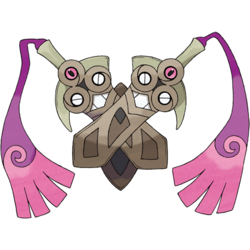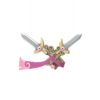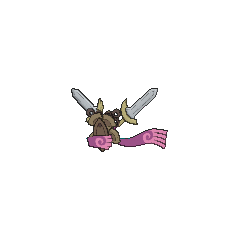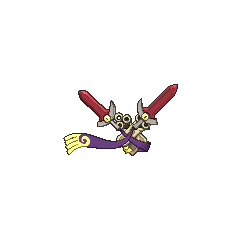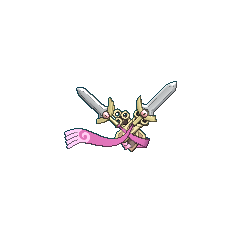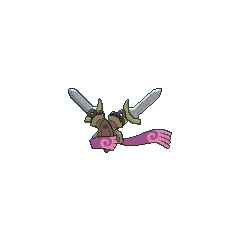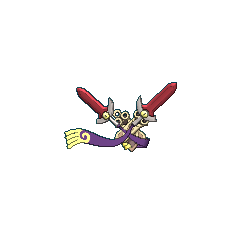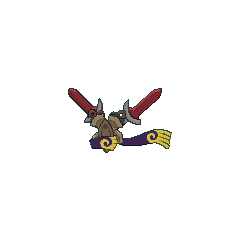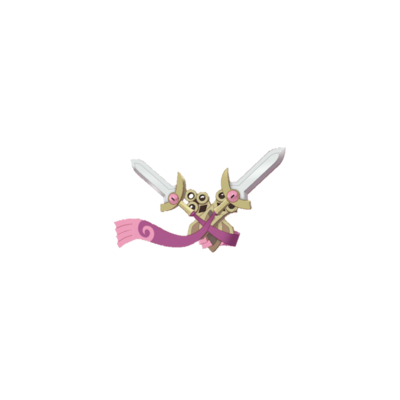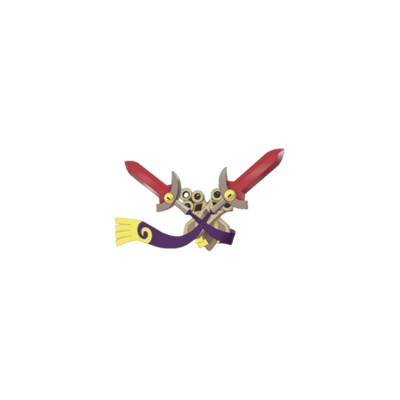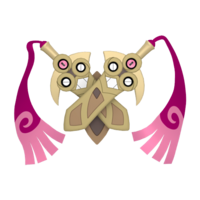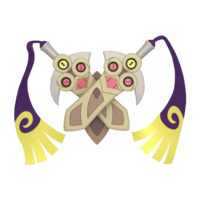From Bulbapedia, the community-driven Pokémon encyclopedia.
Doublade (Japanese: ニダンギル Nidangill) is a dual-type Steel/Ghost Pokémon introduced in Generation VI.
It evolves from Honedge starting at level 35 and evolves into Aegislash when exposed to a Dusk Stone.
Biology
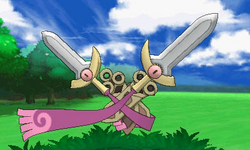
Doublade with its sheaths removed
Doublade is a Pokémon composed of two swords. Each sword has a silver blade and a light gray hilt. Embedded in each hilt is a single, pink gem with a dark center that appears to be an eye. Attached to each pummel is a long, dark purple sash with a pink swirl pattern on the tip; the tip of the sashes split into four tassels. Doublade has two sheathes that are attached to a plaque. The sheathes are varying shades of brown with lines forming a triquetra pattern across the front. Near the top of each sheath are white teeth-like markings and rings with white centers that resemble eyes. A third ring extends onto the hilt and encircles the actual eye.
Doublade excels in both defensive and offensive strategies. Doublade's two swords are able to communicate telepathically, and they use this ability to carry out complex attacks that are unstoppable even by those skilled at swordplay. When rubbing its two blades together, Doublade can emit a metallic sound that is unnerving to the opponents.
Evolution
Doublade evolves from Honedge and evolves into Aegislash.
(For specifics on this Pokémon's Evolution in the games, refer to Game data→Evolution data.)
Game data
Pokédex entries
| This Pokémon was unavailable prior to Generation VI.
|
| Generation VI
|
|
Kalos
Central #118
|
|
Hoenn
#—
|
| X
|
When Honedge evolves, it divides into two swords, which cooperate via telepathy to coordinate attacks and slash their enemies to ribbons.
|
| Y
|
The complex attack patterns of its two swords are unstoppable, even for an opponent greatly accomplished at swordplay.
|
| Omega Ruby
|
When Honedge evolves, it divides into two swords, which cooperate via telepathy to coordinate attacks and slash their enemies to ribbons.
|
| Alpha Sapphire
|
The complex attack patterns of its two swords are unstoppable, even for an opponent greatly accomplished at swordplay.
|
|
|
|
|
|
|
|
|
Game locations
| This Pokémon was unavailable prior to Generation VI.
|
|
|
|
|
|
|
|
|
In side games
| This Pokémon was unavailable prior to Generation VI.
|
|
|
|
|
| Generation VIII
|
|
| This Pokémon is unavailable in Generation VIII side games.
|
|
|
|
|
Stats
Base stats
| Stat
|
Range
|
| At Lv. 50
|
At Lv. 100
|
59
|
|
119 - 166
|
228 - 322
|
110
|
|
103 - 178
|
202 - 350
|
150
|
|
139 - 222
|
274 - 438
|
45
|
|
45 - 106
|
85 - 207
|
49
|
|
48 - 111
|
92 - 216
|
35
|
|
36 - 95
|
67 - 185
|
Total: 448
|
Other Pokémon with this total
|
- Minimum stats are calculated with 0 EVs, IVs of 0, and (if applicable) a hindering nature.
- Maximum stats are calculated with 252 EVs, IVs of 31, and (if applicable) a helpful nature.
|
Type effectiveness
| Under normal battle conditions in Generation IX, this Pokémon is:
|
|
|
|
|
|
|
|
|
|
|
|
|
Learnset
Doublade is available in Sword and Shield.
|
|
|
|
- Bold indicates a move that gets STAB when used by Doublade
- Italic indicates a move that gets STAB only when used by an Evolution of Doublade
- Click on the generation numbers at the top to see level-up moves from other generations
|
|
|
|
|
- Bold indicates a move that gets STAB when used by Doublade
- Italic indicates a move that gets STAB only when used by an Evolution of Doublade
- Click on the generation numbers at the top to see TM moves from other generations
|
|
|
|
|
- Moves marked with an asterisk (*) must be chain bred onto Doublade in Generation VIII
- Moves marked with a double dagger (‡) can only be bred from a Pokémon who learned the move in an earlier generation.
- Moves marked with a superscript game abbreviation can only be bred onto Doublade in that game.
- Bold indicates a move that gets STAB when used by Doublade
- Italic indicates a move that gets STAB only when used by an Evolution of Doublade
- Click on the generation numbers at the top to see Egg moves from other generations
|
|
|
|
|
- Bold indicates a move that gets STAB when used by Doublade
- Italic indicates a move that gets STAB only when used by an Evolution of Doublade
- Click on the generation numbers at the top to see Move Tutor moves from other generations
|
|
|
|
|
- Bold indicates a move that gets STAB when used by Doublade
- Italic indicates a move that gets STAB only when used by an Evolution of Doublade
|
By transfer from another generation
| Generation VIII
|
| Other generations:
|
| VII - IX
|
|
|
|
|
- Transferred Pokémon only retain these moves in Pokémon Sword and Shield
- A striped background indicates a generation in which the move can only be obtained via event or as a special move
- Bold indicates a move that gets STAB when used by Doublade
- Italic indicates a move that gets STAB only when used by an Evolution of Doublade
- × indicates a move that cannot be used in Sword and Shield
- Click on the generation numbers at the top to see transfer-only moves for other generations
|
Side game data
|
|
Pokémon Rumble Rush

|
Walking Speed: 1.67 seconds
|
Base HP: 50
|
|
| Base Attack: 77
|
Base Defense: 59
|
Base Speed: 60
|
|
|
|
|
|
|
|
|
Evolution data
Sprites
| This Pokémon was unavailable prior to Generation VI.
|
|
|
|
|
|
|
| This Pokémon is unavailable in Generation IX.
|
|
|
In the anime
Major appearances
Doublade debuted in Diancie and the Cocoon of Destruction, under the ownership of Argus Steel. It was commonly used by Argus's daughter Millis for transport.
Doublade made its main series debut in A Full-Strength Battle Surprise!, under the ownership of Sawyer, where it was revealed to have evolved from his Honedge. It was used in Sawyer's battle against Ash, but was defeated by Noivern. Doublade evolved into an Aegislash sometime before Valuable Experience for All!.
Minor appearances
Pokédex entries
| Episode
|
Pokémon
|
Source
|
Entry
|
| XY119
|
Doublade
|
Ash's Pokédex
|
Doublade, the Sword Pokémon and the evolved form of Honedge. Doublade's attacks are so rapid and intricate, it is said to be impossible for even a master swordsman to stop them.
|
|
In the manga
Pokémon Adventures
In Charizard Transforms, Celosia used a Doublade in her battle against Shauna on the route to Pokémon Village. It was later used against Shauna again in Xerneas Gives, only to be defeated by Shauna's Kitty.
Sordward's Doublade first appeared in Unbending!! Meet the Celebrities, attacking Henry and Casey.
In the TCG
- Main article: Doublade (TCG)
Trivia
Origin
Doublade appears to be based conceptually on a pair of fully sentient, possessed magical swords. Considering the crossed swords and shield connecting the Pokémon together, it is probably based on a coat of arms. The fact that it started off as an ordinary sword as a Honedge may mean it could be based on the bushido mythos behind katana use; katanas possessed the user samurai's soul and attacked of its own free will. Visually, considering its build and hilt, Doublade seems to be based on a pair of either spatha, claymore, or possibly jian swords with their own scabbards, tassel-like prehensile limbs, and a shared shield connecting its scabbards together.
Name origin
Doublade may be a combination of double and blade.
Nidangill may be a combination of 二 ni (two), 二段 nidan (second level, second stage), 断 dan (to sever), and 切る/斬る kiru (to cut, to slay with a blade), or kill.
In other languages
| Language
|
Title
|
Meaning
|
 Japanese Japanese
|
ニダンギル Nidangill
|
From 二 ni, 断 dan , and 斬る kiru or kill
|
 French French
|
Dimoclès
|
From di- and Damocles
|
 Spanish Spanish
|
Doublade
|
Same as English name
|
 German German
|
Duokles
|
From duo and Damokles
|
 Italian Italian
|
Doublade
|
Same as English name
|
 Korean Korean
|
쌍검킬 Ssanggeomkill
|
From 쌍 (雙) ssang, 검 (劍) geom, and kill
|
 Mandarin Chinese Mandarin Chinese
|
雙劍鞘 / 双剑鞘 Shuāngjiànqiào
|
From 雙 / 双 shuāng, 劍 / 剑 jiàn, and 鞘 qiào
|
 Cantonese Chinese Cantonese Chinese
|
雙劍鞘 Sēunggimchiu
|
From 雙 sēung, 劍 gim, and 鞘 chiu
|
|
|
|
| More languages
|
 Hindi Hindi
|
डायब्लेड Dieblade
|
From die or di- and blade
|
 Russian Russian
|
Дублейд Dubleyd
|
Transcription of English name
|
 Thai Thai
|
นิดังกิล Nidangkin
|
Transcription of Japanese name
|
|
|
|
Related articles
References
External links

|
This Pokémon article is part of Project Pokédex, a Bulbapedia project that aims to write comprehensive articles on each Pokémon species, as well as Pokémon groups and forms.
|
 For other sprites and images, please see Doublade images on the Bulbagarden Archives.
For other sprites and images, please see Doublade images on the Bulbagarden Archives.


